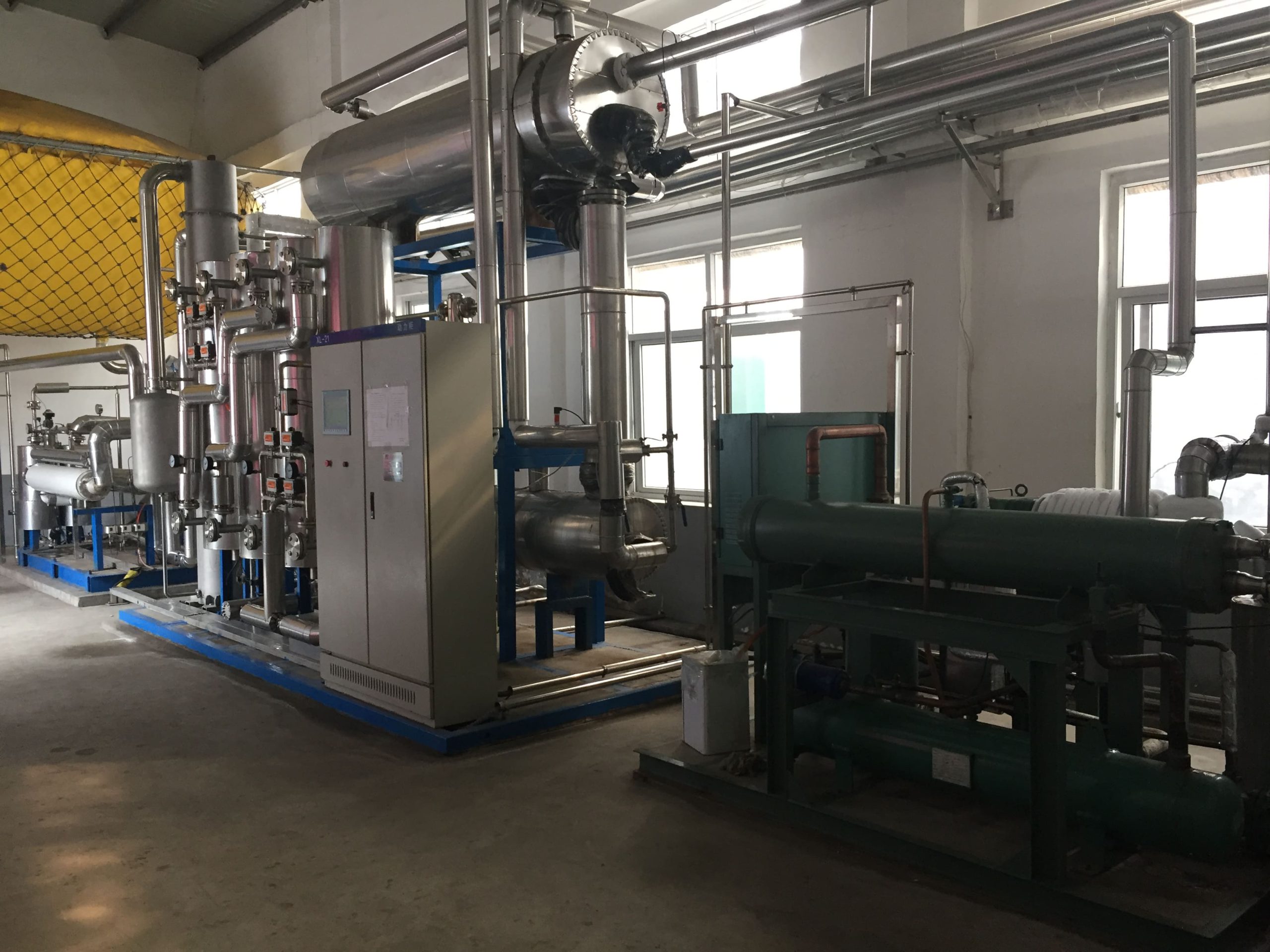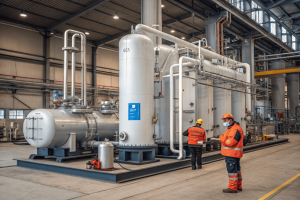How is recovered CO₂ stored and reused?
•
How is recovered CO₂ stored and reused?
You have invested in a recovery system and now have a stream of pure CO₂. But what's next? Handling a gas under pressure seems complex, and you need a safe and efficient way to store and reuse it.
Recovered CO₂ is compressed and chilled into a liquid, then stored in a specialized, insulated cryogenic tank. For reuse, the liquid is drawn from the tank and warmed through a vaporizer, turning it back into a precise, controllable gas for applications like carbonation.

As an engineer at FTL Machine, I've seen this process become the beating heart of our clients' operations. The storage tank acts like a buffer, a battery for CO₂. It provides a constant, reliable supply, completely decoupling the production of CO₂ from its consumption. This simple, elegant system is what turns a waste stream into a powerful on-demand utility, giving you full control over your process.
What is the process of CO2 capture and storage?
The term "carbon storage" sounds massive and complicated, like something that requires underground caverns. You're worried the logistics for your plant will be too complex or expensive to manage.
For on-site applications, the process is straightforward. It involves capturing the raw gas from your process, purifying it by removing moisture and other trace elements, and liquefying it under pressure and cold temperatures for storage in a dedicated tank right at your facility.

The "storage" part in our industry is much simpler than the large-scale geological sequestration you hear about in the news. We are not burying the gas forever. We are simply putting it into a liquid form for easy, dense, and safe storage on-site until it's needed again. I always tell my clients to think of the storage tank like a water tower for CO₂—it's there to provide pressure and supply whenever you turn on the tap.
From Gas to Liquid: The On-Site Journey
The entire process is designed to efficiently convert a low-pressure gas into a high-density liquid. This dramatic volume reduction is what makes on-site storage practical and economical. The journey has four key stages:
| Stage | Description | Key Equipment |
|---|---|---|
| Capture | Collecting the raw, low-pressure CO₂ gas from the source, like a fermenter. | Gas collection balloon, booster compressor |
| Purification | Removing impurities like water, oxygen, and volatile organic compounds (VOCs). | Water scrubber, dryers, activated carbon filters |
| Liquefaction | Chilling and pressurizing the purified gas until it turns into a liquid. | Refrigeration unit, condenser, high-pressure compressor |
| Storage | Holding the liquid CO₂ in a specially designed, insulated vessel. | Cryogenic, vacuum-insulated storage tank |
The final liquid is typically stored at around -18°C and 300 psig (21 bar). Under these conditions, it is stable, dense, and ready for reuse.
What is the process of capturing carbon dioxide CO2 from specific sources and storing it called?
You hear many different acronyms thrown around, like CCS, CCU, and CCUS. It's confusing, and you want to be sure you are using the right terminology and understanding the right concepts.
The overall process is called Carbon Capture, Utilization, and Storage (CCUS). When CO₂ is captured and then reused for another purpose, it is specifically called Carbon Capture and Utilization (CCU). If it is permanently stored underground, that is Carbon Capture and Storage (CCS).

This is an important distinction I always clarify with clients. While all of these terms start with "Carbon Capture," the end goal is very different. Our work at FTL Machine is almost entirely focused on CCU. We help businesses create a circular economy within their own walls. They capture their CO₂ and utilize it as a valuable commodity. CCS, on the other hand, is a climate mitigation strategy designed to take CO₂ from massive emitters and lock it away for good.
CCU vs. CCS: Two Different Goals
Understanding the difference between Utilization and Storage is key to understanding where our technology fits. One is about creating value, and the other is about waste disposal.
| Feature | Carbon Capture & Utilization (CCU) | Carbon Capture & Storage (CCS) |
|---|---|---|
| Primary Goal | Turn CO₂ from a waste into a valuable product. | Permanently remove CO₂ from the carbon cycle. |
| End Point | Reused on-site or sold for other processes. | Injected into deep geological formations. |
| Common Users | Breweries, distilleries, biogas plants, food packagers. | Power plants, cement factories, steel mills. |
| Our Focus | This is our core business and expertise. | This is a separate, specialized industry. |
The systems we design and build are CCU systems. They are designed to produce a high-purity product that can be safely and effectively reused, delivering a tangible economic return on investment.
What are the three steps of carbon capture and storage?
You want to understand the fundamental building blocks of a CO₂ recovery project. Breaking it down into a few simple steps will help you grasp the entire process and plan your project.
The three fundamental steps are Capture, Transport, and Storage. Capture involves separating the CO₂. Transport means moving it to its destination. Storage refers to containing it, either in a tank for reuse (Utilization) or underground for permanent sequestration.

For the projects I work on, these three steps happen on a very local scale. The 'Capture' is our recovery plant connected to a fermenter. The 'Transport' is often just a pipe running 50 feet across the facility from the recovery skid to the storage tank. And the 'Storage' is the cryogenic tank located right on their property. It demystifies the process when you realize it all happens within your own site boundary.
The On-Site Workflow
In the context of a food and beverage or biofuel plant, these three steps form a seamless, automated loop that supports your daily production.
- Capture (Separation & Purification): This is the core function of the CO₂ recovery plant. It takes the wet, impure gas directly from your production source (like a fermentation tank) and runs it through a series of processes to clean and dry it, resulting in a stream of high-purity CO₂ gas. This step is critical for ensuring the final product meets food-grade standards.
- Transport (Compression & Liquefaction): To move and store CO₂ efficiently, we must drastically reduce its volume. This step involves compressing the purified gas and chilling it in a condenser until it becomes a liquid. The liquid CO₂ is then piped to the nearby storage vessel.
- Storage (Containment & Reuse): The liquid CO₂ is held in a cryogenic storage tank. This insulated tank maintains the low temperature and high pressure needed to keep the CO₂ in its liquid state. From this tank, it can be supplied on-demand to the point of use, such as a beverage carbonator or a packaging line.
Conclusion
Recovered CO₂ is stored as a liquid in on-site cryogenic tanks. This creates a reliable supply that can be easily vaporized back into a gas for reuse in various industrial processes.
You may also be interested in:

Why is CO₂ recovery technology gaining popularity worldwide?
Why is CO₂ recovery technology gaining popularity worldwide? You see headlines about carbon capture everywhere. But you wonder if it's
Read more
How is a CO₂ recovery system designed to fit different industries?
How is a CO₂ recovery system designed to fit different industries? You're under pressure to implement a CO₂ recovery solution.
Read more
How energy-efficient are today’s CO₂ recovery technologies?
How energy-efficient are today’s CO₂ recovery technologies? You want to recover CO₂, but you fear that high electricity bills will
Read more